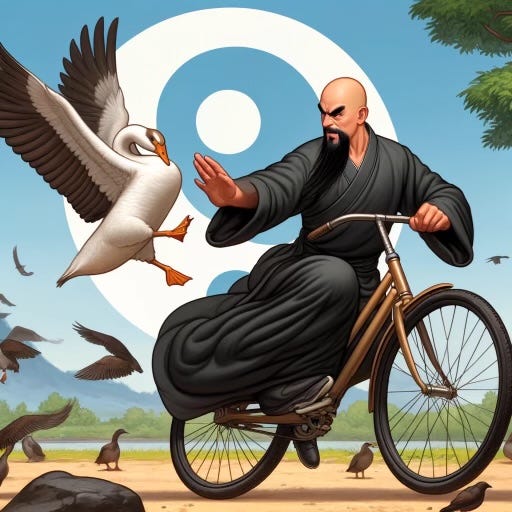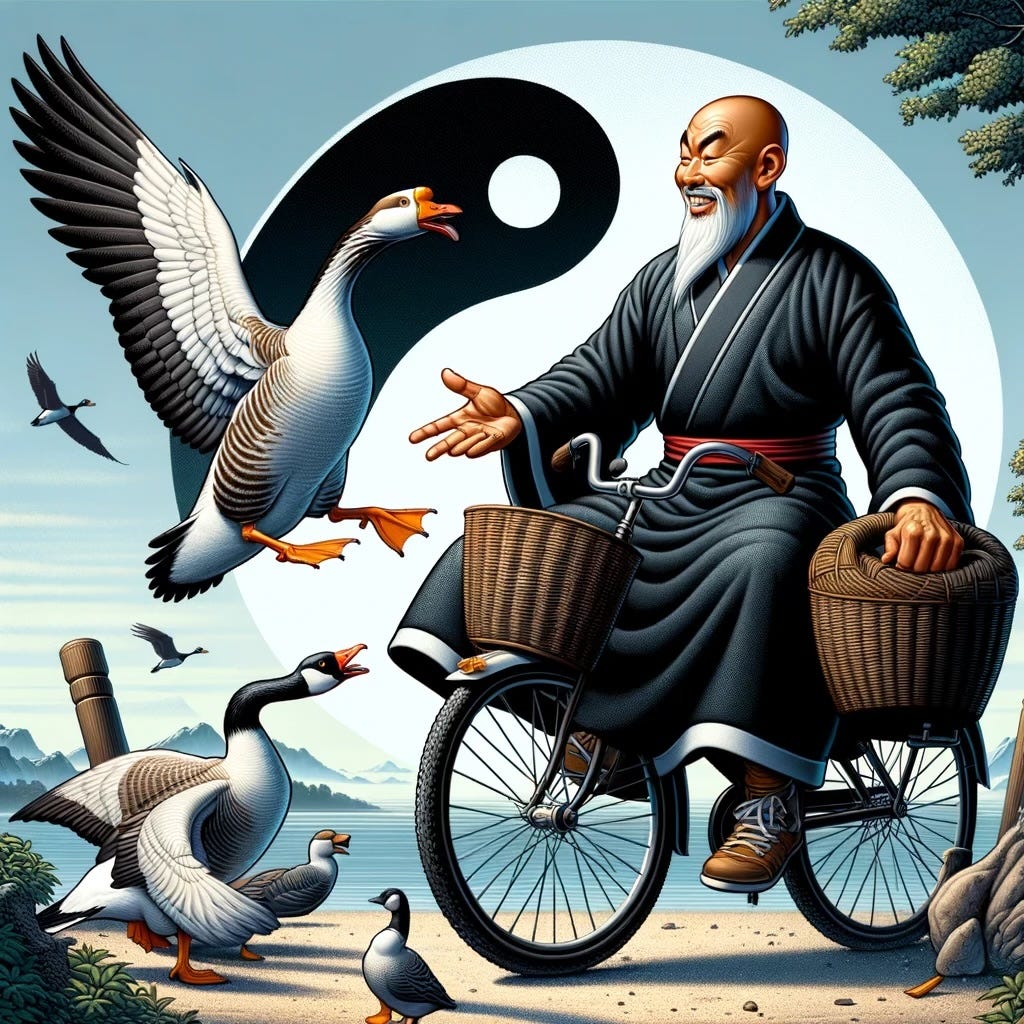Reflections On My Confrontation With an Angry Goose
An Eastern Philosophical Lesson In Presence and Equanimity?
As I pedaled yesterday along a picturesque trail here in Fort Collins, the tranquility of my bike ride was shattered by the sudden and aggressive approach of a wild goose. This feathered harbinger of chaos had seemingly materialized out of nowhere, honking furiously as it gave chase, determined to defend its territory against a two-wheeled intruder.
At that moment, time seemed to slow down as I weighed my options. Should I try to outpace the goose, or was that a futile endeavor against such an agile and persistent adversary? Instinctively, I pedaled harder, but the goose matched my speed with ease, its wings flapping furiously as it closed the distance between us.
Just as I was about to concede defeat, the goose took to the air, its powerful wings propelling it directly over my head. In a split-second decision, I ducked, narrowly avoiding a collision, but the sudden maneuver caused me to veer off the path, careening dangerously close to a nearby cafe patio where patrons watched the unfolding scene with a mix of amusement and concern.
As I regained control of my bike and steadied my nerves for the remainder of my ride, I couldn't help but reflect on the deeper lessons this encounter had to offer. It’s here where the principles of Eastern philosophy, particularly the I-Ching and Tao Te Ching, provide a profound framework for understanding and navigating such unexpected and potentially disruptive experiences.
The I Ching, with its emphasis on the natural flow of change and the importance of adaptability, reminds us that even the most seemingly chaotic events are part of a larger, interconnected system. The wild goose's aggressive behavior, far from being a random act of aggression, was likely a response to perceived threats within its own environment. By recognizing this, we can cultivate a sense of empathy and understanding, rather than reacting with fear or anger.
The Tao Te Ching, with its teachings on the power of nonaction and the virtues of presence, offers a sobering counterpoint to our modern, fast-paced world. In the face of the goose's relentless pursuit, the temptation was to react with panic and try to outmaneuver it. However, the Taoist perspective reminds us that true power lies in accepting the present moment, in finding the stillness within the chaos.
As I regained my composure and continued on my way, I couldn't help but chuckle at the absurdity of the situation. The image of a lone cyclist, desperately ducking to avoid a dive-bombing goose, while a group of onlookers watched with amusement, was undoubtedly a sight to behold. Yet, in that moment, I found a sense of humor and levity that helped to diffuse the tension and restore a sense of equilibrium.
In the end, my encounter with the wild goose served as a poignant reminder of the importance of presence, adaptability, and a sense of humor in the face of life's unexpected challenges. By drawing on the wisdom of Eastern philosophy, I was able to shift my perspective, acknowledging the interconnectedness of all things and the value of nonaction in the face of disruption.
As I pedaled on, the memory of the goose's fierce display lingered, a humbling yet oddly inspiring reminder that even in the midst of chaos, we can find moments of clarity, growth, and, yes, even laughter. For in the end, it is our ability to embrace the present moment, to find the Tao within the turmoil, that truly empowers us to navigate the unpredictable journeys of life.
The Chocolate Taoist is a reader-supported publication. To receive my weekly reflections and aid my independent writing journey, please consider becoming a subscriber or member supporter.
Every little bit counts.
PS: My book “The Way of the Chocolate Taoist” is set to release on September 1, 2024. A free copy will be sent to all paid member supporters.




A great story! Seeing the bigger picture is always a clearer perspective than when we are simply stuck in our own experience.
Great story and lesson! Question: how did you find the exactly perfect illustrations! AI?